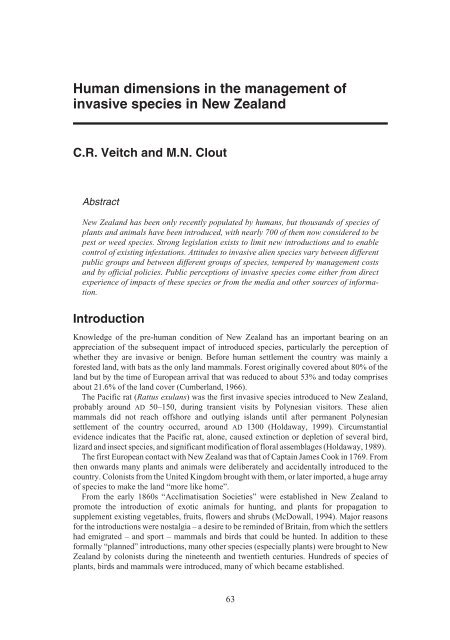Alien Species.vp - IUCN
Alien Species.vp - IUCN
Alien Species.vp - IUCN
Create successful ePaper yourself
Turn your PDF publications into a flip-book with our unique Google optimized e-Paper software.
Human dimensions in the management of<br />
invasive species in New Zealand<br />
C.R. Veitch and M.N. Clout<br />
Abstract<br />
New Zealand has been only recently populated by humans, but thousands of species of<br />
plants and animals have been introduced, with nearly 700 of them now considered to be<br />
pest or weed species. Strong legislation exists to limit new introductions and to enable<br />
control of existing infestations. Attitudes to invasive alien species vary between different<br />
public groups and between different groups of species, tempered by management costs<br />
and by official policies. Public perceptions of invasive species come either from direct<br />
experience of impacts of these species or from the media and other sources of information.<br />
Introduction<br />
Knowledge of the pre-human condition of New Zealand has an important bearing on an<br />
appreciation of the subsequent impact of introduced species, particularly the perception of<br />
whether they are invasive or benign. Before human settlement the country was mainly a<br />
forested land, with bats as the only land mammals. Forest originally covered about 80% of the<br />
land but by the time of European arrival that was reduced to about 53% and today comprises<br />
about 21.6% of the land cover (Cumberland, 1966).<br />
The Pacific rat (Rattus exulans) was the first invasive species introduced to New Zealand,<br />
probably around AD 50–150, during transient visits by Polynesian visitors. These alien<br />
mammals did not reach offshore and outlying islands until after permanent Polynesian<br />
settlement of the country occurred, around AD 1300 (Holdaway, 1999). Circumstantial<br />
evidence indicates that the Pacific rat, alone, caused extinction or depletion of several bird,<br />
lizard and insect species, and significant modification of floral assemblages (Holdaway, 1989).<br />
The first European contact with New Zealand was that of Captain James Cook in 1769. From<br />
then onwards many plants and animals were deliberately and accidentally introduced to the<br />
country. Colonists from the United Kingdom brought with them, or later imported, a huge array<br />
of species to make the land “more like home”.<br />
From the early 1860s “Acclimatisation Societies” were established in New Zealand to<br />
promote the introduction of exotic animals for hunting, and plants for propagation to<br />
supplement existing vegetables, fruits, flowers and shrubs (McDowall, 1994). Major reasons<br />
for the introductions were nostalgia – a desire to be reminded of Britain, from which the settlers<br />
had emigrated – and sport – mammals and birds that could be hunted. In addition to these<br />
formally “planned” introductions, many other species (especially plants) were brought to New<br />
Zealand by colonists during the nineteenth and twentieth centuries. Hundreds of species of<br />
plants, birds and mammals were introduced, many of which became established.<br />
63












